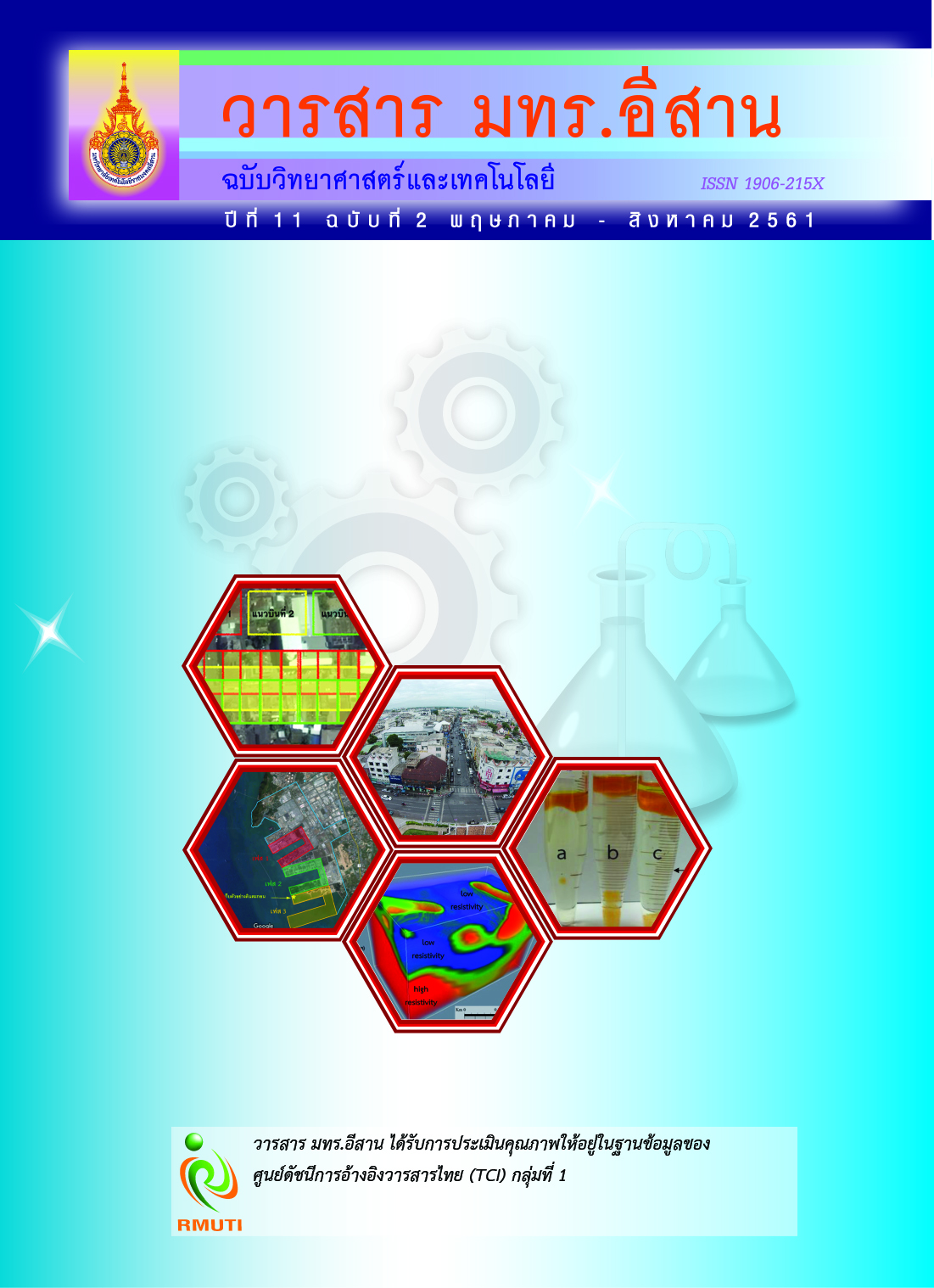การประเมินสภาพธรณีวิทยาแหล่งนํ้าพุร้อนด้วยเทคนิคการวัดค่าความต้านทานไฟฟ้า
Main Article Content
บทคัดย่อ
งานวิจัยนี้เป็นการนำเสนอรูปแบบการสำรวจหาแหล่งน้ำพุร้อนด้วยเทคนิคการวัดค่าความต้านทานไฟฟ้าแบบ 3 มิติ จากการวางขั้วไฟฟ้าแบบออฟเซ็ทโพล - ไดโพล (Offset Pole-Dipole) ณ บ้านพุน้ำร้อน อำเภอด่านช้าง จังหวัดสุพรรณบุรี โดยติดตั้งขั้ววัดกระแสไฟฟ้าและกำหนดจุดปล่อยกระแสไฟฟ้าครอบคลุมพื้นที่ขนาด 1.60 x 1.60 ตารางกิโลเมตร กำหนดให้แนวขั้วปล่อยกระแสไฟฟ้าและแนวขั้ววัดไฟฟ้ามีระยะห่างเท่ากับ 100 เมตร ภายในพื้นที่การสำรวจและระยะห่างของขั้วปล่อยกระแสไฟฟ้าภายนอกพื้นที่การสำรวจมีระยะห่างเท่ากับ 200 เมตร ผลการศึกษาแสดงให้เห็นถึงสภาพธรณีวิทยาแบบ 3 มิติ ของพื้นที่ที่ทำการสำรวจพบว่าจุดที่อยู่บริเวณแนวภูเขามีค่าความต้านทานไฟฟ้าสูงกวา่ 3,500 โอห์ม-เมตร ซึ่งสอดคล้องกับลักษณะของหินที่พบบนเนินเขา คือ หินจำพวกแกรนิต ควอทซ์และเฟลสปาร์ สำหรับตอนกลางของพื้นที่มีค่าความต้านทานไฟฟ้าอยู่ระหว่าง 30 - 500 โอห์ม-เมตร ซึ่งแสดงให้เห็นถึงตำแหน่งของนํ้าใต้ดิน ดินตะกอน รอยเลื่อน และชั้นหินผุ
จากการศึกษาพบว่า ลักษณะโครงสร้างทางธรณีวิทยาซึ่งเป็นที่ตั้งของแหล่งนํ้าพุร้อนแห่งนี้มีลักษณะที่สอดคล้องกับแบบจำลองน้ำพุร้อนแบบที่ 2 ที่ถูกค้นพบในประเทศไทย กล่าวคือน้ำร้อนจะไหลขึ้นตามลอยเลื่อนผสมกับน้ำใต้ดินที่มีอุณหภูมิต่ำกวา่ และถูกกักเก็บไว้อยู่ในชั้นหิน ผลการวิเคราะห์แสดงให้เห็นถึงลักษณะทางธรณีวิทยาและขนาดของบ่อนํ้าพุร้อนในรูปแบบของภาพ 3 มิติ ซึ่งแสดงให้เห็นถึงสภาพทางธรณีวิทยาโดยรวมได้อย่างชัดเจนกว่าการสำรวจด้วยวิธีการปกติ
Article Details
เอกสารอ้างอิง
[2] Raksaskulwong, M. (1999). Geothermal Energy Development and Utilization in Thailand; in NEDO (ed.). Proceedings of Asia Geothermal Symposium. New Energy and Industrial Technology Development Organization (NEDO). Tokyo, Japan. pp. 70-86
[3] Department of Mineral Resources of Thailand. (2011). Hot Springs Resources. Access (10 May 2017). Available (https://www.dmr.go.th)
[4] Badmus, B., Akinyemi, O., Olowofela, J., and Folarin, G. (2012). 3D Electrical Resistivity Tomography Survey for the Basement of the Abeokuta Terrain of Southwestern Nigeria. Journal of the Geological Society of India. Vol. 80, Issue 6, pp. 845-854. DOI: 10.1007/s12594-012-0213-x
[5] Loke, M. H. (2014). RES3DINV Program. Access (30 July 2017). Available (https://www.geoelectrical.com)
[6] Giao, P. H., Putthapiban, P., and Vichalai, C. (2007). Geophysical Investigation of Hot Springsites in Kanchanaburi with Reference to Local Tourism Development. GEOTHAI’07 International Conference on Geology of Thailand: Towards Sustainable Development and Sufficiency Economy. pp. 104-108
[7] Neawsuparp, K. Soisa, T., and Charusiri, P. (2010). Physical Characteristic of Pong-Kum Hot Spring, Chiang Mai, Thailand, Using Ground Geophysical Investigation. Proceedings World Geothermal Congress 2010 Bali, Indonesia, 25-29 April 2010. pp. 1-5
[8] Suanburi, D. (2014). The Application of 3D Resistivity Measurements to Study Subsurface Geological Structure of Pong - Chang Hot Spring Situated at Ban Pongchang, Nongprue District, Kanchanaburi. Proceedings of DMR Conference 2014. 9-10 September 2014, Bangkok, Thailand. (in Thai)
[9] Spencer, H. W., Kaewsomwang, P., Suvagonda, F., and Warapan, S. (2016). Fang Hot Springs Geothermal Area, Chiangmai Province, Northern Thailand. Proceedings of Geological and Geophysical Exploration in 2014-2015. The 11th Asian Geothermal Symposium 18-20 November, 2016, Chiangmai, Thailand.
[10] Loke, M. H. (2010). Tutorial: 2-D and 3-D Electrical Imaging Surveys. Access (23 July 2017). Available (https://www.geoelectrical.com).
[11] White, R., Collins, S., Denne, R., Hee, R., and Brown, P. (2001). A New Survey Design for 3D IP Inversion Modelling at Copper Hill. Exploration Geophysics. Vol. 32, No. 3-4, pp. 152-155
[12] Loke, M. H. (2001). RES3DMOD V2.13f Program. Access (30 July 2017). Available (https://www.geoelectrical.com).
[13] Zhdanov, M. S. (2002). Geophysical Inverse Theory and Regularization Problems. (1st Edition). Elsevier. New York. pp. 628-630
[14] Raksaskulwong, M. (2008). Thailand Geothermal Energy: Development History and Current status. Proceedings of the 8th Asian Geothermal Symposium. Department of Mineral Resources of Thailand. pp. 39-46
[15] Palacky, G. J. (1987). Resistivity Characteristics of Geologic Targets, in Nabighian, M.N., ed., Electromagnetic methods in applied geophysics theory: Tulsa, Okla., Society of Exploration Geophysicists. Vol. 1, pp. 53-129
[16] Wiwattanachang, N., Vichalai, C., and Jantasuto, O. (2016). Dam Stability Analysis by Electrical Resistivity Imaging and Natural Electric Potential Technique. RMUTI Journal Science and Technology. Vol. 10, No. 1, pp. 35-48. (in Thai)
[17] Department of Mineral Resources of Thailand. (2007). Geological Map Suphan-Buri Province. Access (25 July 2017). Available (www.dmr.goq.th)


